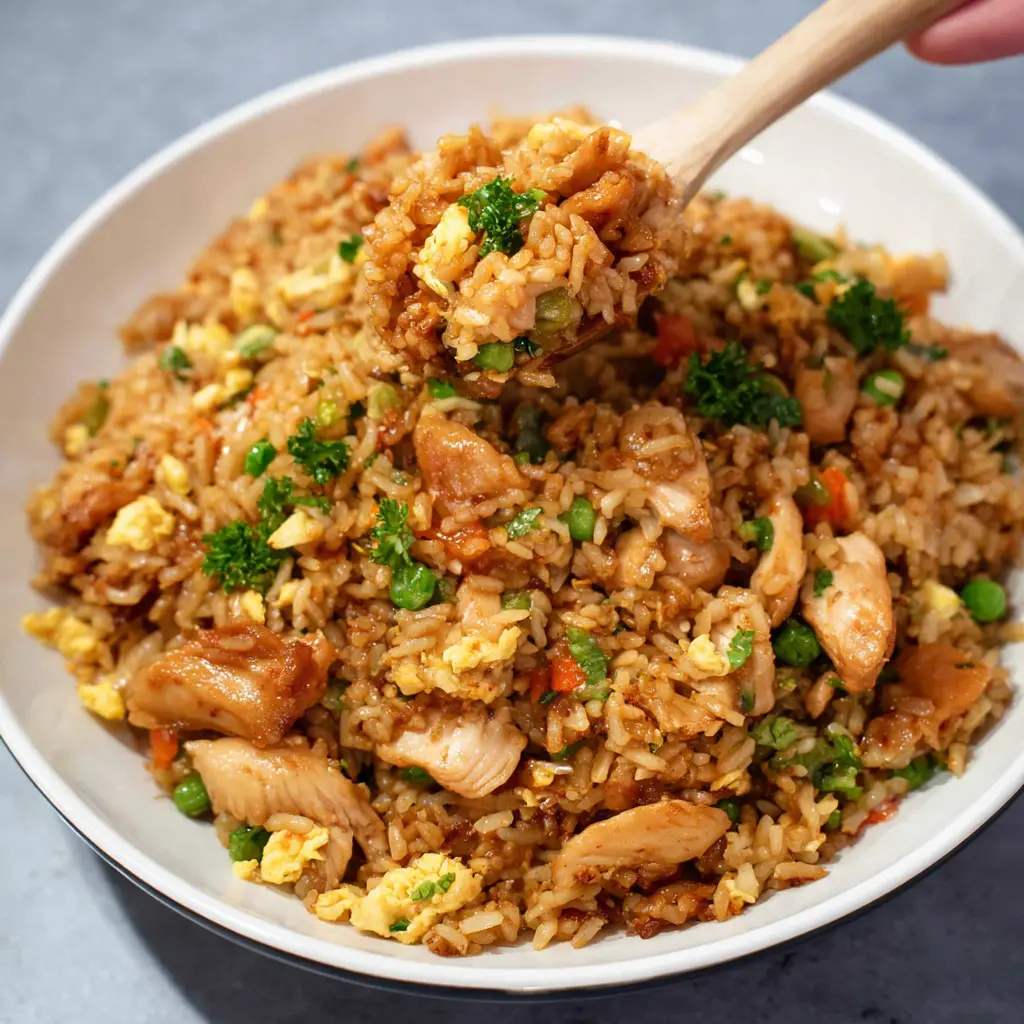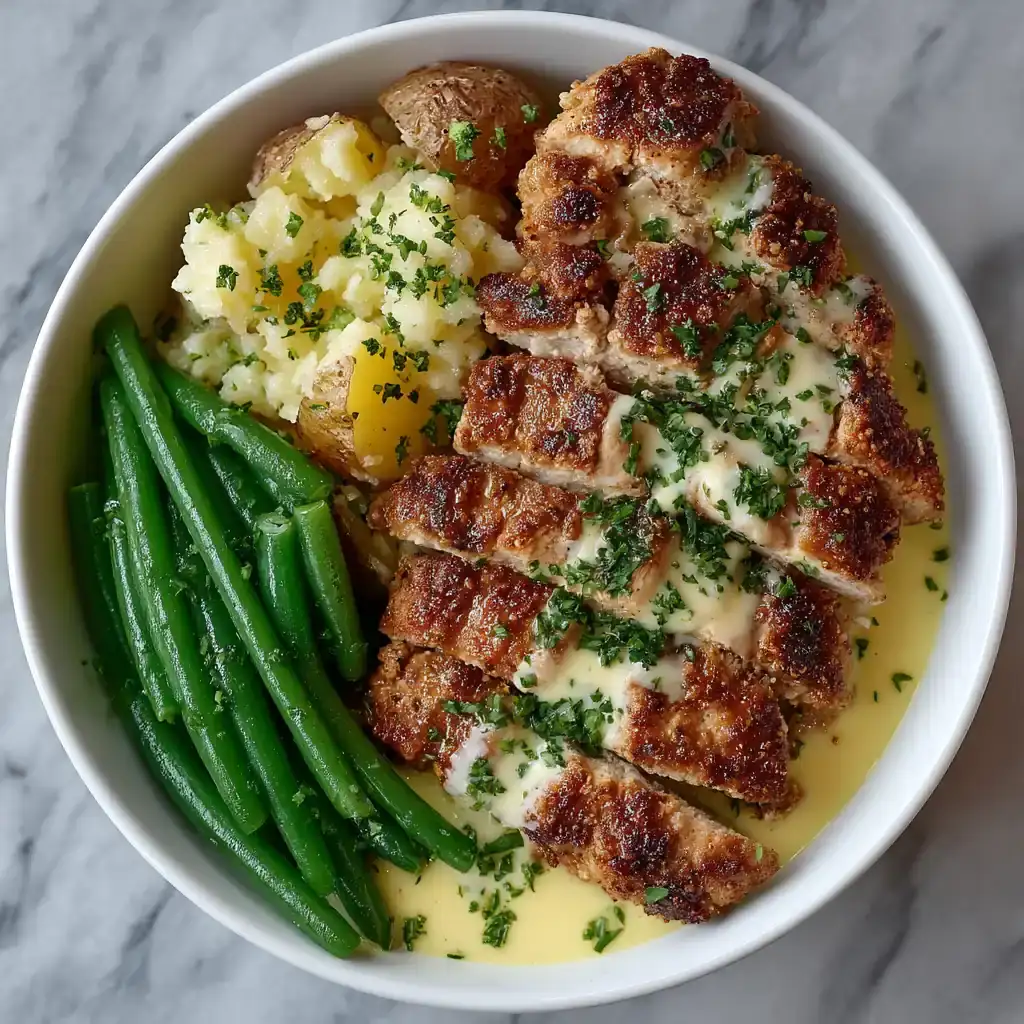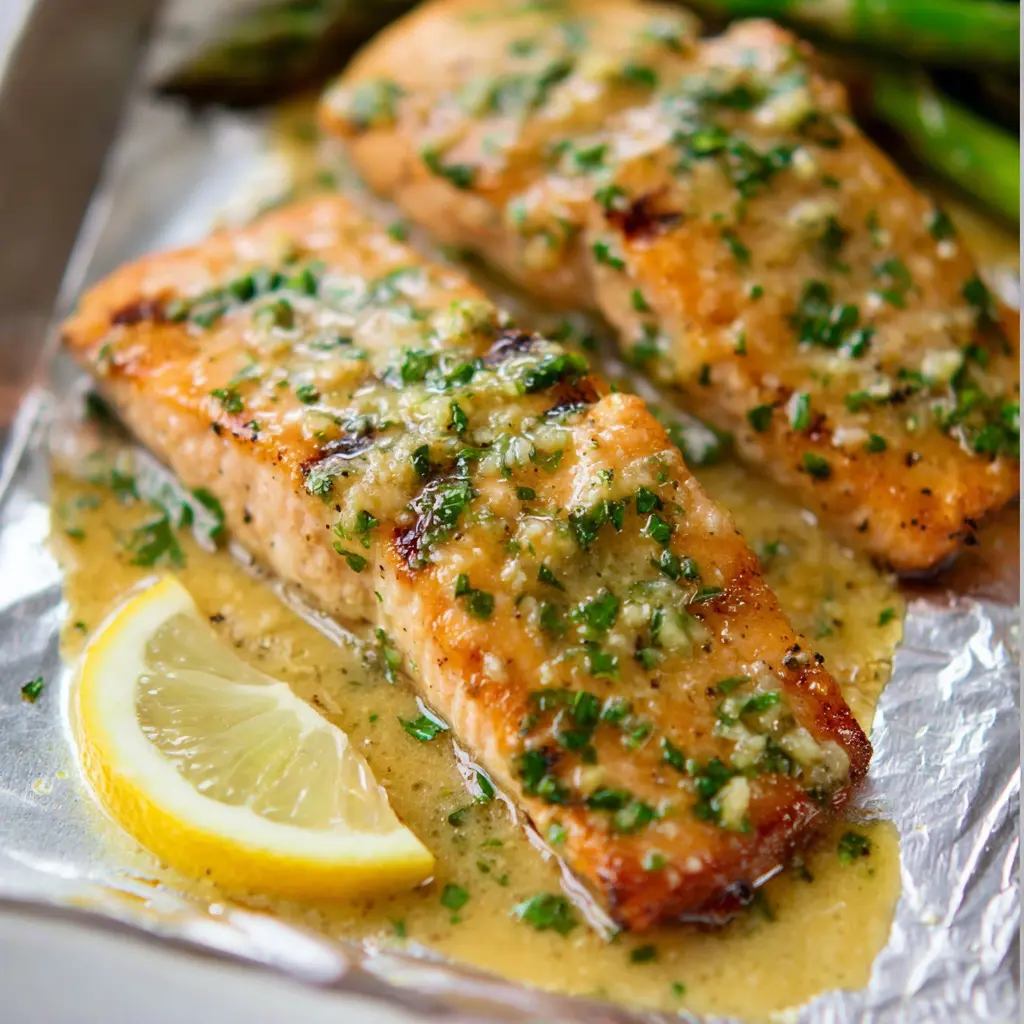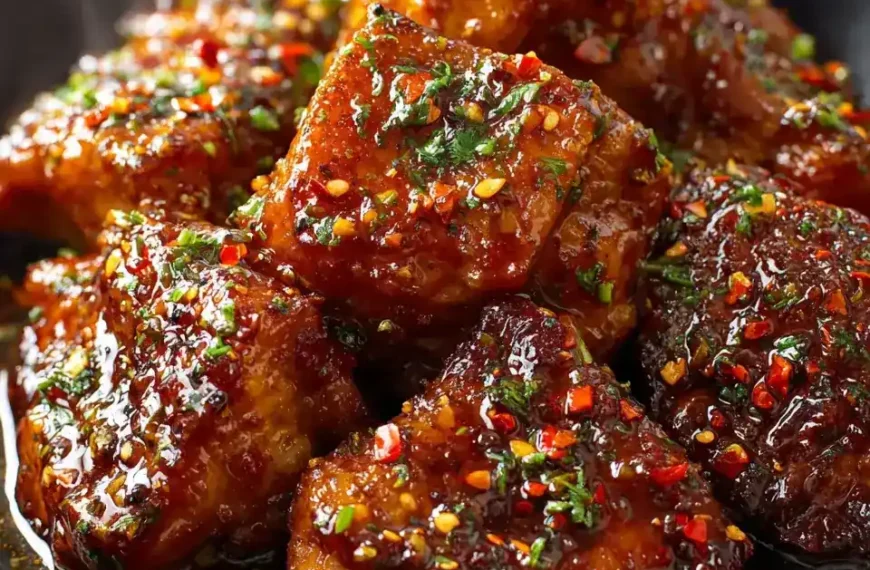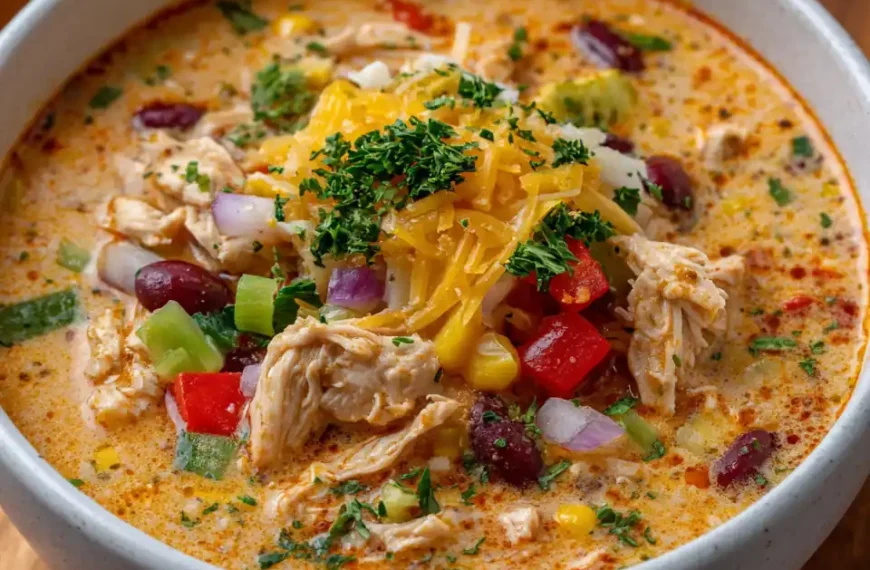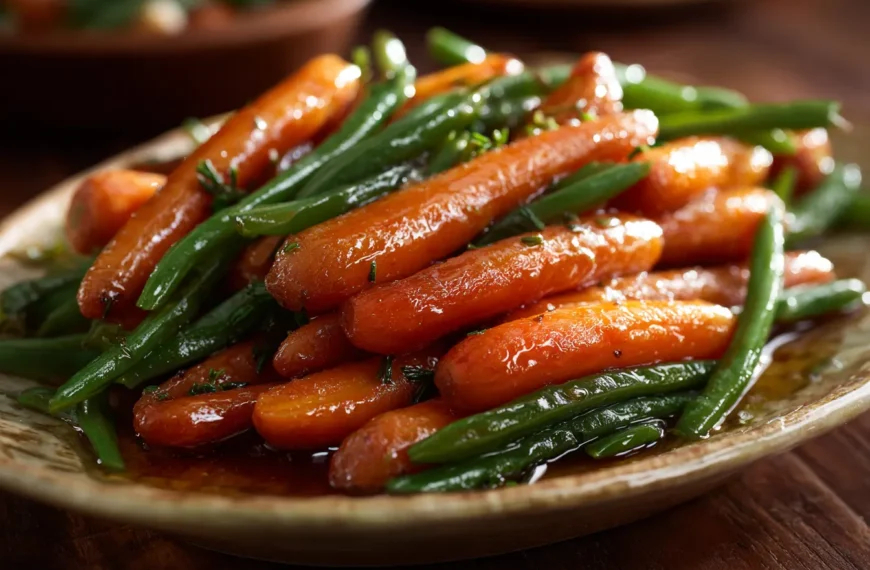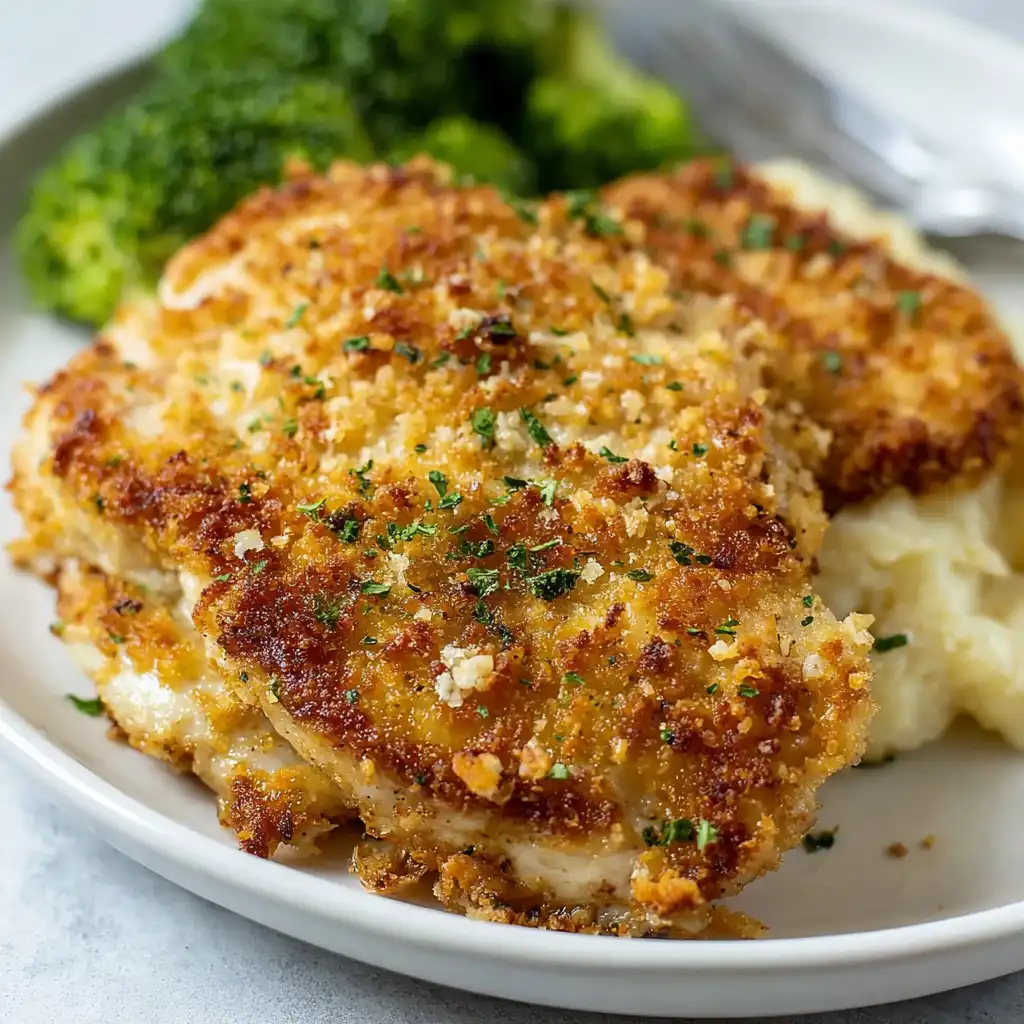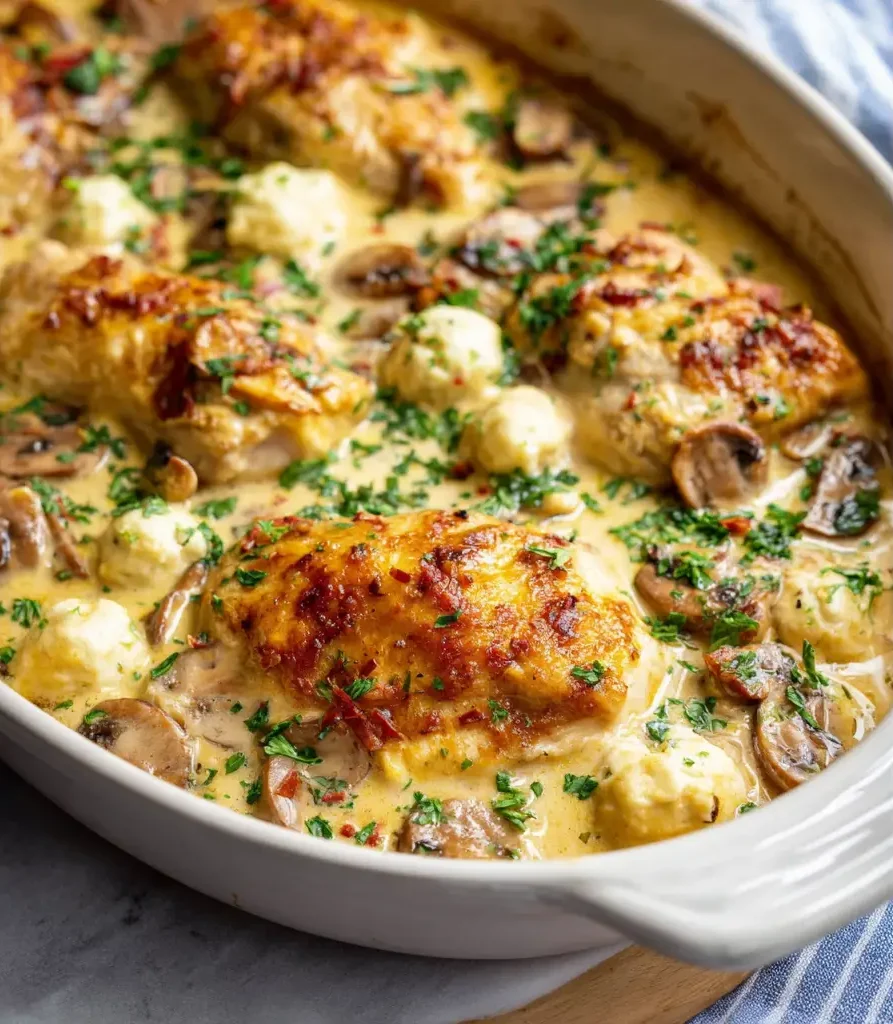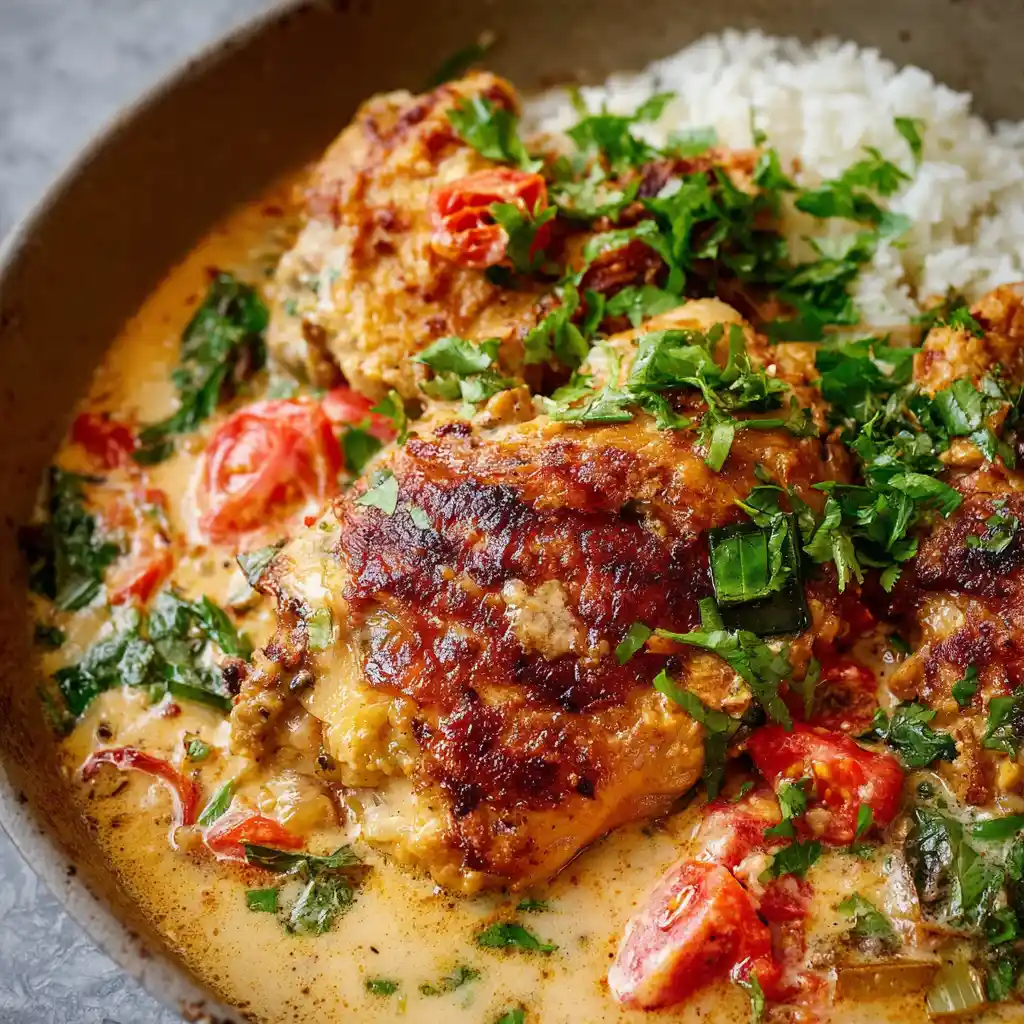Article Introduction
Chinese chicken fried rice is one of those dishes that instantly reminds me of weeknight takeout dinners with my family growing up. We’d open those white paper boxes around the kitchen island, and the aroma of sesame oil, garlic, and that golden soy glaze would fill the air. It always felt like a treat, especially when the rice had that perfect balance of tender chicken, fluffy grains, and little pops of vegetables.
Eventually, I started making my own at home, chasing that same nostalgic flavor. What surprised me was how easy it actually is with a few pantry staples and some leftover rice. In this article, you’ll learn how to make Chinese chicken fried rice that rivals your favorite restaurant. We’ll cover the secrets behind its bold flavor, how to prep your rice just right, and how to master that irresistible stir-fry texture.
Let’s dive into the world of homemade Chinese chicken fried rice with techniques that are simple, flavor-packed, and always satisfying.
Chinese Chicken Fried Rice: A Flavor-Packed Weeknight Hero
A Comfort Food Classic with a Homemade Twist
Fried rice has long been a comfort dish for so many families, mine included. I first started cooking it out of necessity. Leftover rice in the fridge, a few frozen veggies in the back of the freezer, and a single piece of chicken were all I needed to whip up something filling. But as I kept making it, I began to notice how those little tweaks—like marinating the chicken or toasting the sauce in the pan—transformed it from basic to crave-worthy.
Chinese chicken fried rice is more than just stir-fried rice. It’s about getting that savory depth of flavor, the slight chew in each grain, and the balance between protein, veggies, and seasoning. The best part? It comes together in under 30 minutes, especially when you’ve got day-old rice ready to go.
Whether it’s a lazy Sunday meal or a quick post-work dinner, this dish delivers big flavor in a simple, satisfying way.
Why Day-Old Rice Makes All the Difference
One of the biggest secrets to perfect fried rice is using cold, day-old jasmine rice. Freshly cooked rice is too moist and soft, which can lead to a clumpy or soggy texture. When rice sits overnight in the fridge, the grains firm up, making it ideal for frying. They separate easily in the pan and soak up the sauces without getting mushy.
If you’re starting with uncooked rice, the trick is to rinse it well to remove surface starch and use just enough water to steam it without turning it wet. Once it’s cooked, give it time to cool uncovered before storing it in the fridge. By the next day, it’s ready to be turned into flavorful, golden fried rice that’s anything but sticky or bland.
That little bit of planning ahead turns your rice from average to amazing.
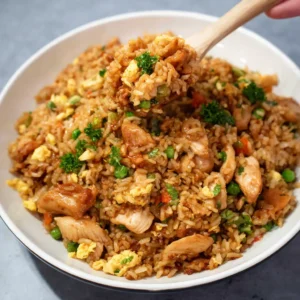
Quick & Easy Chicken Fried Rice
Ingredients
- 4 ½ cups cooked jasmine rice cold day-old or see Notes below to prepare uncooked rice for this recipe
- ½ lb skinless boneless chicken thighs thinly sliced
- 1.5 cups frozen peas and carrots or frozen vegetable mix corn, peas, carrots, green beans
- 3 large eggs beaten
- 1 small shallot or ¼ onion finely diced
- 3 garlic cloves minced
- 4 teaspoon vegetable oil or any neutral tasting oil
- Chicken Marinade
- 1 teaspoon regular soy sauce or light soy sauce
- 1 teaspoon Shaoxing Cooking Wine or dry sherry / dry white wine / chicken broth
- 1 teaspoon cornstarch
- 1 teaspoon vegetable oil or any neutral tasting oil
- Sauce
- 2 tablespoon regular soy sauce or light soy sauce
- ½ tablespoon dark soy sauce
- 2 teaspoon sesame oil
- 1 teaspoon chicken bouillon powder a.k.a. chicken stock powder
- ⅛ teaspoon white pepper or black pepper
Instructions
- In a medium-sized bowl, marinate sliced chicken thighs with marinade ingredients as listed above. Set aside to marinate for 5-10 minutes.
- In a small bowl, combine the sauce ingredients as listed above and set aside.
- Heat 1 teaspoon / 5 ml of vegetable oil in a large pan on medium-high heat. Fry chicken until fully cooked. Remove from the pan.
- Add 1 teaspoon / 5 ml of vegetable oil into the pan. Sauté garlic and shallots for 10 seconds. Add peas and carrots and fry for 10 seconds. Push everything to the side of the pan.
- Add remaining oil into empty space of the pan. Add in beaten eggs and let them sit for 20 seconds before scrambling and breaking into bite-sized pieces. Then toss everything together.
- Add rice and chicken and toss everything together until incorporated.
- Pour sauce around the rice or along the edges of the pan and let the sauce toast for 5 seconds for extra flavor before tossing. Toss everything together until all the rice grains are brown. Enjoy!
Notes
For a serving for 4, measure out 1 ½ cups or 300 grams of uncooked jasmine rice. Then cook it the night before in your rice cooker or in a pot (see instructions below) and then refrigerate.
To cook rice without a rice cooker:
Rinse rice under cold running water until it runs clear and then strain. Transfer strained rice to a medium-sized pot or pan, ideally non-stick.
Then place your index finger above the rice and fill it with fresh cold water to the the first knuckle line of the finger.
Cover with a lid and bring to a boil on medium heat. Then reduce to low heat and keep covered. Cook for 12-14 minutes until most of the water has evaporated. If there’s water in the base of the pot, continue to cook on low until there isn’t.
Take the pot off the heat. Let this rest covered for another 10-12 minutes so the rice can properly cook through a steaming process. The finished rice will be sticky (not wet) and you should be able to fluff it with a rice paddle.
The Flavor Foundations of Chinese Chicken Fried Rice
Key Ingredients That Make Every Bite Count
A truly delicious Chinese chicken fried rice starts with a thoughtful selection of simple, high-impact ingredients. It’s not about using fancy products. It’s about knowing how to bring out the best in each one.
Chicken thighs are ideal for this dish. They’re more flavorful and tender than breast meat, especially when marinated. A quick soak in soy sauce, Shaoxing wine (or a splash of dry sherry), and cornstarch does two things—it tenderizes the chicken and adds a subtle umami depth. The oil in the marinade helps keep the chicken juicy during cooking.
Next, vegetables. Frozen peas and carrots (or a mix with corn and green beans) are classic. They’re easy to toss in the pan and add pops of sweetness and color that balance the savory elements.
Aromatics like shallots and garlic build the base flavor. Even if you don’t see them in the finished dish, their aroma runs through every bite.
And don’t skip the eggs. Cooked right in the pan with everything else, they add richness and texture that round everything out.
The Secret Sauce Behind That Takeout Taste
The sauce might be the shortest part of the recipe, but it’s the most powerful. It’s what transforms a bowl of rice and chicken into something layered and crave-worthy.
Here’s what you need:
- Light soy sauce: Salty and savory, this forms the backbone of flavor.
- Dark soy sauce: Adds a deeper color and caramel-like richness.
- Sesame oil: Just a touch goes a long way, bringing warmth and nutty aroma.
- Chicken bouillon powder: This is the ingredient that gives the dish that unmistakable restaurant-style punch. It’s salty, savory, and a little rich—exactly what fried rice needs.
- White pepper: Earthy and slightly sharp, it’s subtle but noticeable in authentic fried rice.
The key is not just tossing these in. Pouring the sauce along the edges of the hot pan lets it toast before mixing. That quick sear unlocks more flavor than you’d expect.
These ingredients come together in under a minute, but the impact is bold and unmistakable. It’s what makes this recipe feel like true Chinese chicken fried rice, not just “rice with stuff in it.”
Mastering the Cooking Method for Chinese Chicken Fried Rice
The Right Order Makes All the Difference
Making great fried rice isn’t hard, but there’s a specific order to follow for the best results. The key is cooking each component separately before bringing everything together at the end. This keeps the textures balanced nothing soggy, nothing overcooked.
Start by heating 1 teaspoon of oil in a large non-stick pan or wok over medium-high heat. Once hot, add the marinated chicken. Stir-fry until it’s fully cooked and slightly browned on the edges, then remove it from the pan. This step helps the chicken stay juicy and lets it build a little flavor crust.
Next, add another teaspoon of oil and toss in the garlic and shallots. Cook them for about 10 seconds—just until fragrant. Then, stir in the frozen veggies. Cook these quickly to keep their color and a slight crunch.
Now for the eggs. Push everything to one side of the pan and add the remaining oil. Pour in the beaten eggs and let them sit for about 20 seconds before stirring. This lets them set into soft curds before you scramble them. Once cooked, mix the eggs with the veggies.
At this point, it’s time to reintroduce the cooked chicken and add the cold rice. Break up any clumps with your spatula and fold everything together gently. You don’t want to mash the grains.
Finally, the sauce. Pour it around the edges of the pan, not directly in the center. Let it sizzle for a few seconds before mixing. This caramelizes the sauce slightly and adds that distinct toasted soy flavor that’s signature in good fried rice.
Avoid These Common Mistakes for Better Results
It’s easy to rush fried rice, but a few small errors can really affect the final dish. One of the biggest mistakes is using fresh, hot rice. It sticks together and turns gummy. If you don’t have day-old rice, spread freshly cooked rice on a tray to cool, then refrigerate it for at least 2 hours.
Another issue is overcrowding the pan. Fried rice needs space and high heat. If your pan is too small, the ingredients will steam instead of fry. Use a large skillet or wok and cook in batches if needed.
Don’t skip the step of toasting the sauce either. It may seem small, but those few seconds make a noticeable difference in depth of flavor.
And lastly, don’t stir too aggressively. You want the rice grains to stay intact and fluffy. Use a gentle folding motion with a flat spatula.
With these steps, you’ll end up with fried rice that’s aromatic, well-textured, and loaded with flavor without needing a restaurant wok burner.
Make It Your Way: Variations and Serving Tips
Simple Tweaks to Fit Any Taste or Pantry
One of the best things about Chinese chicken fried rice is how easy it is to adjust based on what you have on hand. Once you’ve mastered the base version, it becomes a flexible weeknight go-to.
Want to add more vegetables? Go for it. Try chopped bell peppers, shredded cabbage, or even broccoli florets. Just make sure to cook firm vegetables a bit longer so they soften before adding rice.
Looking for extra protein? You can swap or add shrimp, diced pork, or even tofu. If you’re going meatless, marinated tofu stir-fried until crispy is a great substitute for chicken.
If you like a bit of heat, stir in a spoonful of chili garlic sauce or sprinkle some crushed red pepper flakes when adding the sauce. You can also finish the dish with fresh chopped scallions or a drizzle of chili oil for a punchy finish.
For a gluten-free version, use tamari or coconut aminos in place of soy sauce, and double-check the bouillon powder label.
With just a few changes, this recipe transforms into a completely different meal while keeping that classic fried rice flavor you love.
How to Store and Reheat Without Losing Texture
Leftover fried rice keeps well, which makes it perfect for meal prep. Store any cooled rice in an airtight container in the fridge for up to 3 days. For longer storage, freeze it in single portions for up to 2 months.
When reheating, avoid the microwave if possible. Instead, heat a skillet over medium heat with a small splash of oil. Stir-fry the rice for a few minutes until hot. This keeps the texture firm and the grains separate unlike microwaving, which can turn everything soft and uneven.
If you do use a microwave, cover the container loosely and add a damp paper towel on top to retain moisture. Reheat in 30-second bursts, stirring between rounds.
To serve, fried rice works beautifully on its own or as part of a larger meal. Pair it with a light soup, dumplings, or sautéed greens like bok choy. It also makes a great side for dishes like sesame chicken or beef and broccoli.
However you enjoy it, this Chinese chicken fried rice brings warmth, flavor, and comfort to the table every time.
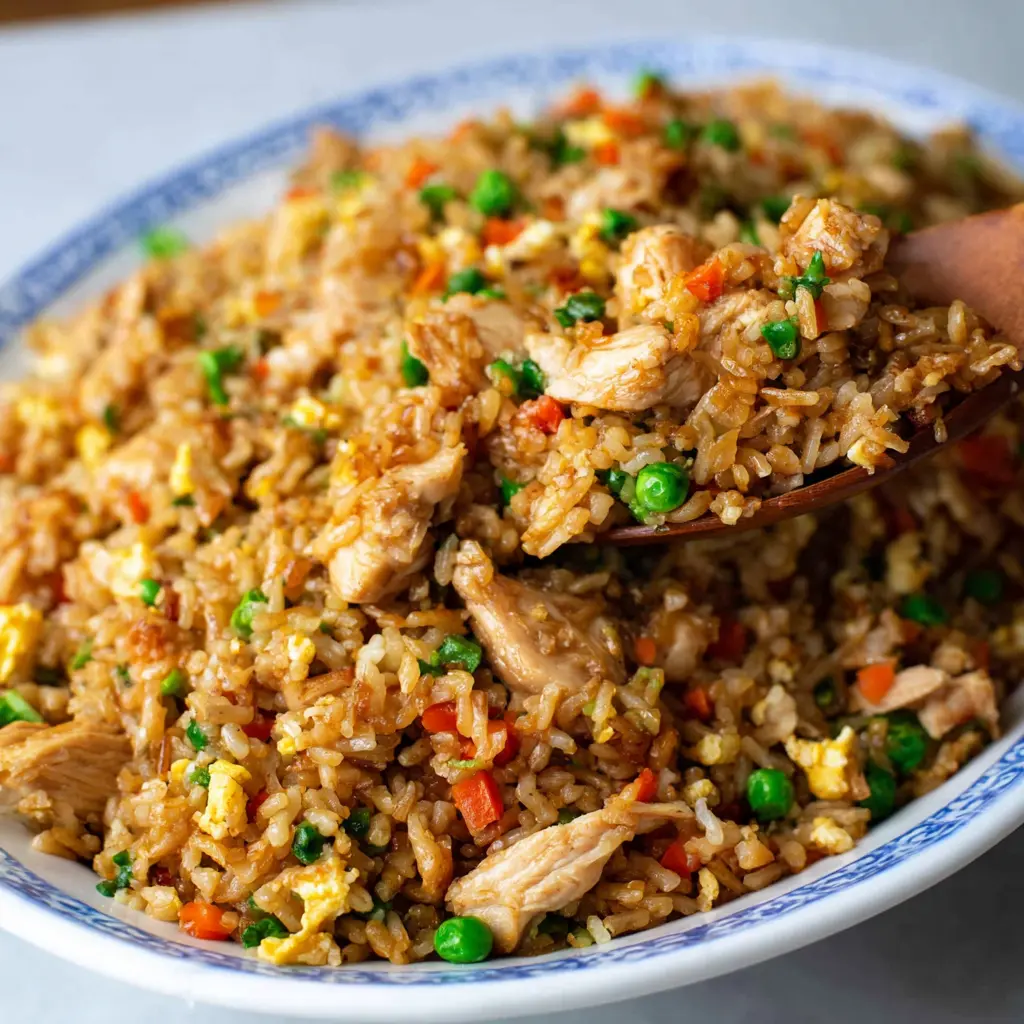
Frequently Asked Questions
What’s in Chinese chicken fried rice?
Classic Chinese chicken fried rice includes jasmine rice, marinated chicken thighs, eggs, garlic, shallots, frozen mixed vegetables, and a flavorful soy-based sauce. It’s a complete dish with protein, grains, and vegetables, all cooked in one pan for convenience and flavor.
What gives Chinese fried rice its flavour?
The signature flavor comes from soy sauces (both light and dark), sesame oil, garlic, and sometimes chicken bouillon powder. Toasting the sauce briefly in the pan before mixing enhances its richness and gives fried rice that slightly smoky, umami depth you expect from restaurant-style versions.
What is the secret of Chinese fried rice?
The real secret lies in using cold, day-old rice and layering the cooking steps. Frying ingredients separately, toasting the sauce before mixing, and cooking over high heat all help develop complex flavors and the right texture. Marinating the chicken also makes a big difference in taste and tenderness.
What ingredients are in Chinese fried rice?
The core ingredients are cold jasmine rice, eggs, soy sauce, sesame oil, vegetables (like peas and carrots), and some type of protein—often chicken, shrimp, or pork. Garlic and onion or shallots are often added for aroma, and white pepper or bouillon powder may be used for extra flavor.
Conclusion
Homemade Chinese chicken fried rice is all about balance—tender chicken, flavorful rice, vibrant vegetables, and that irresistible sauce tying it all together. What started for me as a way to use leftovers has turned into one of my most requested family meals. It’s quick, cozy, and deeply satisfying.
Whether you stick to the classic version or throw in your favorite add-ins, this dish proves that comfort food doesn’t have to be complicated. A bit of prep, a hot pan, and cold rice are all you need to bring the flavors of your favorite takeout home.
